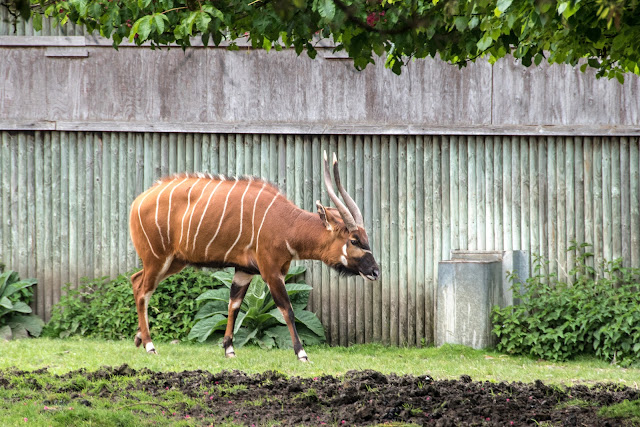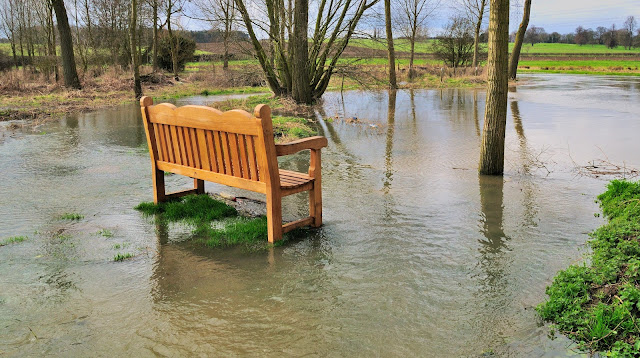Monday dawned a little dull- and got duller as we headed back along the A2 toward a wild animal sanctuary called Howletts Wild Animal Park. It is an amazing place to spend a few hours - or all day!
Wikipedia says:
Howletts Wild Animal Park (formerly known as Howletts Zoo) was set up as a private zoo in 1957 by John Aspinall near Canterbury, Kent. The animal collection was opened to the public in 1975.To give more room for the animals another estate at Port Lympne near Hythe, Kent was purchased in 1973, and opened to the public as Port Lympne Zoo in 1976.
The collection is known for being unorthodox, for the encouragement of close personal relationships between staff and animals, and for their breeding of rare and endangered species.
Since 1984 both parks have been owned by The John Aspinall Foundation, a charity. Following his death, Aspinall was buried in front of the mansion house and a memorial was built next to the grave near the bison. A later extension to Howletts was an open-topped enclosure for black and white colobus, just behind the entrance.
The park has the largest breeding herd of African elephants in the United Kingdom
The park is most famous for having some of the largest family groups of western lowland gorillas in the world. It is also home to the largest breeding herd of African elephants in the United Kingdom and has one of the largest breeding groups of lion-tailed macaques in the world.
The weather soon turned warm and we had a glorious day. What follows are a selection, but by no means all, of the animals that we saw that day. Some were difficult to photograph as the netting was in the way.
Eastern Bongo (Tragelaphus eurycerus isaaci) - IUCN Status: Critically endangered
The largest and heaviest of the forest antelopes, Howletts are currently home to 7 bongo, one male and six females. Bongo have brown coats, beautifully marked with 12 to 14 narrow white stripes, providing perfect forest camouflage. The black and white crest running along the spine and lyre-shaped horns are equally distinctive. Eastern bongos are one of the world’s rarest antelopes. They now only occur in small. Fragmented populations in Western Kenya.
Wild mountain bongo populations have suffered huge declines, and are now restricted to a handful of small, isolated populations, all in Kenya
Eastern Black Rhino (Diceros bicornis michaeli) - IUCN Status: Critically endangered
At Howletts are two female black rhino, Salome and Damara and their two calves, a male called Kasungu and a female called Mizi. Kasungu is the first black rhino born at Howletts in 40 years and we were delighted when Salome gave birth in the autumn of 2016, to Mizi.
Black Rhino are critically endangered mainly due to poaching. They are killed for their horns and in recent years the increase has been driven by a growing demand, mostly from Asian consumers who use it in folk remedies, despite proof that it has no medicinal value at all.
The closest living relative to the rhino are tapirs, horses and zebras. They are part of a group of mammals known as odd toed ungulates or Perissodactyla. Rhinos generally have poor eyesight, but they make up for this with their incredible hearing and strong sense of smell.
Despite their size, black rhino are capable of reaching a top speed of around 35 mph and will charge when threatened, lowering their head and using their horn for maximum impact.
African Elephant (Loxodonta africana) - IUCN Status: Vulnerable
The African elephant is the largest and most powerful of all living land mammals. Adults can measure up to 11 ft high at the shoulder and weigh in excess of 6 tonnes! Adult African elephants can eat 150kg or more of foliage, grass, small branches and fruit in one day and also drink 135 litres of water! In the wild, elephants live in herds of related females with their calves led by the oldest cow or ‘matriarch’. Bulls are solitary, leaving the herd at puberty and living in bachelor groups; they join the cows only to mate.
Dhole or Asiatic dog (Cuon alpinus) - Endangered
Asiatic wild dog, red dog, and whistling dog, all names for the same animal. It is about the size of a German shepherd but looks more like a long-legged fox. This highly elusive and skilled jumper is classified with wolves, coyotes, jackals, and foxes in the taxonomic family Canidae. Found in eastern and southern Asia, from Siberia in the north to the Malay Peninsula in the south
Dholes are unusual dogs for a number of reasons. They don’t fit neatly into any of the dog subfamilies (wolf and fox, for instance). Dholes have only two molars on each side of their lower jaw, instead of three, and have a relatively shorter jaw than their doggie counterparts. Also, female dholes have more teats than other canid species and can produce up to 12 pups per litter.
Dholes are incredibly athletic. They are fast runners, excellent swimmers, and impressive jumpers. These skills are critical when the pack is hunting. In some protected areas, they share habitat with tigers and leopards.
Colobus (Black-and-White) Monkey (Colobus guereza kikuyuensi)
Black and white colobus monkeys are old world monkeys. This term describes monkeys from Africa and Asia. These primates have distinctive black and white colouration with long white fur on the back and tail. Babies are born pure white and gradually change to their adult colour as they get older. It is not always the mother who carries her baby. In the wild, this gives the mother time to look for food offer younger members of the group the chance to practice at caring for a baby.
The word 'colobus' is a Greek word meaning 'mutilated'. This name refers to the fact that over time these monkeys have evolved and lost their thumb. This is often common amongst forest primates and is believed to allow the monkeys to travel more easily through tree branches.
Sumatran tiger (Panthera tigris sumatrae) - IUCN Status: Critically endangered
Sumatran tigers are the smallest subspecies of tiger and we look after a stunning pair named Indah and Amir at Howletts. Habitat loss caused by the expansion of palm oil and acacia plantations are the biggest threat to the survival of this species. The illegal trade in tiger parts for traditional medicines and the depletion of its prey base is a contributing factor to the dramatic decline of this beautiful animal.
Capybara
Capybaras are the largest of the rodent species. Weighing as much as a man, these oversized, pig-like animals are highly adapted to an aquatic lifestyle and even mate in the water. Capybaras are found over much of South America. Efficient grazers, they are able to crop even the short, dry grasses left at the end of the dry season. They are capable of a range of vocalisations and can purr and bark. Like rabbits, they eat their own dung to extract maximum nutrition from their food.
Gelada baboons (Theropithecus gelada) - IUCN Status: Least concern
Gelada baboons at Howletts share their large open topped enclosure, near the Gatehouse, with our group of black and white colobus monkeys. Whilst they live together in relative harmony, occasionally a young gelada, full of mischief, will pull the colobus’ tails and run away, which obviously causes a bit of an uproar!
Whilst referred to as a baboon, geladas are actually the last surviving species of a once widespread group of grass grazing primates.
In the wild geladas can only be found on the rocky highland escarpments of Northern Ethiopia. By night they sleep on rocky outcrops and during the day, they graze on the lush grasslands.
Lemur
Lion-tailed macaque (Macaca silenus) - Endangered
The lion-tailed macaque (Macaca silenus) is a primate that spends most of its time up within trees. These Old World monkeys have lengthy, tufted and slender tails that resemble those of lions, hence their naming. Lion-tailed macaques have rather meek and reclusive dispositions, and because of that do not generally travel very far out of their forest home ranges. In terms of lifespan, these creatures often exceed 30 years in age.
The Brazilian or lowland tapir (Tapirus terrestris) -Vulnerable
Currently home to three males and a female, visitors can often see them enjoying their pools in the summer months and warming up in their cosy sheds in the winter. Brazilian tapirs have remained virtually unchanged for over 20 million years. A relative of the horse and the rhinoceros, tapirs are mainly active at night and use their prehensile upper lip to browse on aquatic plants, twigs, foliage and fruit.
Females give birth to a single calf, after about 13 months. Youngsters are born with stripes and spots on their coats, which help keep them hidden against the forest backdrop
This is a great place to visit, as it is far more than a zoo. The program of breeding the Western lowland gorillas has been very successful, for example, and other breeding programs a helping to keep some species from disappearing altogether.






















































